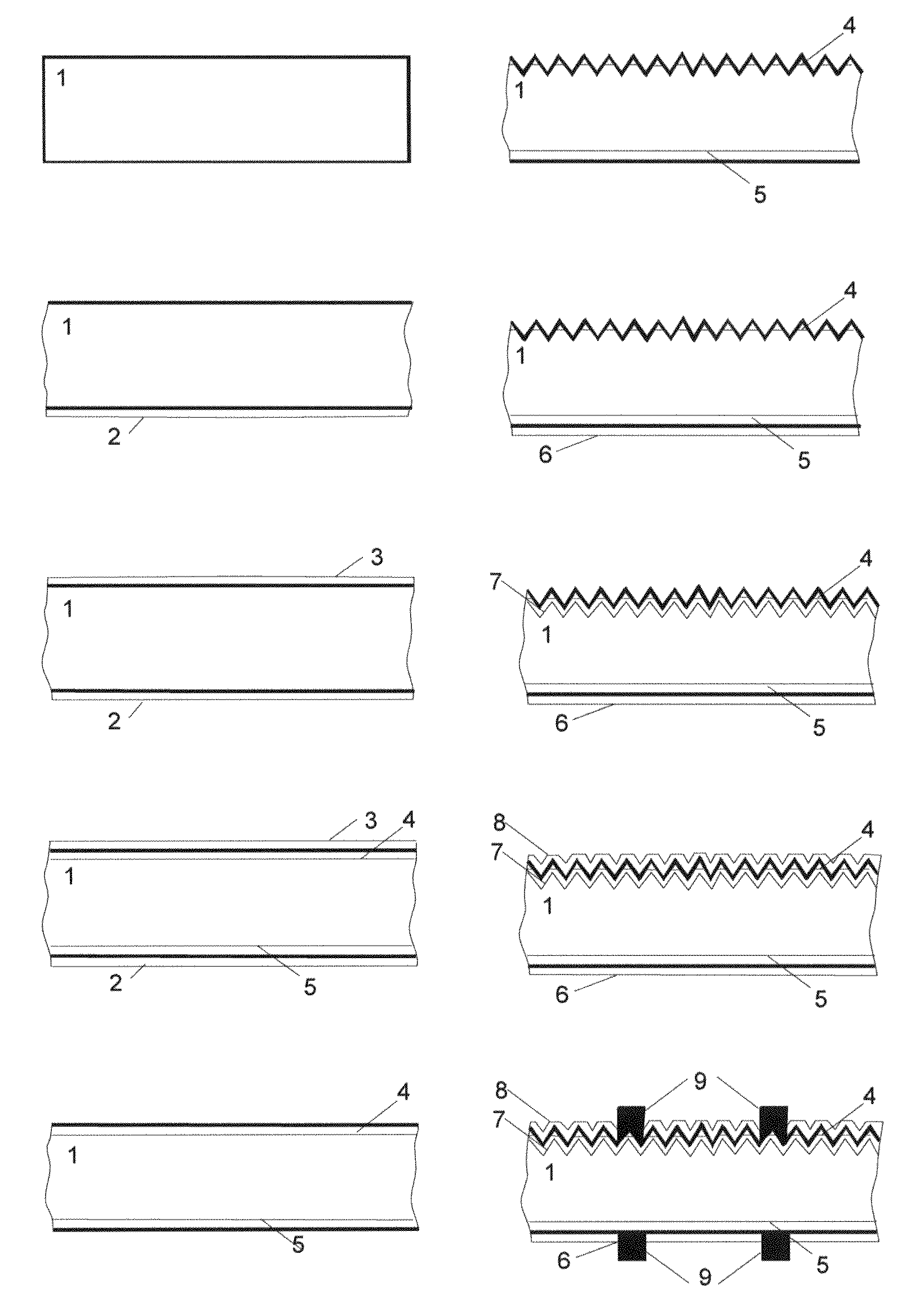Method of manufacturing photovoltaic cells, photovoltaic cells produced thereby and uses thereof
- Summary
- Abstract
- Description
- Claims
- Application Information
AI Technical Summary
Benefits of technology
Problems solved by technology
Method used
Image
Examples
example 1
Exemplary Preparation of Photovoltaic Cells
[0200]p-Type monocrystalline silicon pseudosquare substrates (125×125 mm) with a resistivity of 1.6 ohm were used. The crystal orientation of the substrate surface was [100]. Saw damage was removed by means of etching in a solution of 25% sodium hydroxide. The substrates were then washed in peroxide-ammoniac solution.
[0201]A film of silicon dioxide containing 50% (by weight) of boron oxide was applied to the back side of the substrates employing a spin-on method using a spin rate of 3,000 rpm.
[0202]The substrates were divided into 3 experimental groups of 60 substrates. Films of silicon dioxide containing 20%, 25% or 30% (by weight) P2O5 were applied to the front surface of the substrates employing the spin-on method.
[0203]Diffusion of dopants into the substrate was performed by heating for 20 minutes at a temperature of 1010° C. under a nitrogen atmosphere. The resulting p+ layer on the back side had sheet resistance of 25 ohm or less and ...
example 2
Effect of Antireflective Coatings on Photovoltaic Cell Performance
[0219]Photovoltaic cells were prepared as described in Example 1 with an initial n+ layer having a sheet resistance of 25 ohm and an etching depth of 8 μm. Laser p-n junction separation was performed at a distance of 0.2 mm from the edge of the substrate.
[0220]As described in Example 1, an antireflective coating was applied to the boron-doped surface before formation of the final n+ layer by phosphorus-doping, and an antireflective coating was applied to the final n+ layer following phosphorus-doping.
[0221]In one group, application of the antireflective layer on each side of the photovoltaic cell comprised forming a 75 nm layer of titanium oxide (refractive index=2.2) using an atmospheric pressure chemical vapor deposition (CVD) method, as described in Example 1.
[0222]In a second group, application of the antireflective layer on each side of the photovoltaic cell comprised forming a 60 nm layer of silicon nitride (ref...
example 3
Measurements of Effective Minority Carrier Lifetime
[0227]In order to determine the effect of silicon nitride deposition on surface recombination, the effective minority carrier lifetime was determined in p+-p-p+ structures. p+-p-p+ structures were used instead of the n+-p-p+ structure of a photovoltaic cell in order to simplify interpretation of the experimental results.
[0228]4 samples were prepared from 1 ohm·cm silicon wafers, which were doped on both sides with boron by applying a film of silicon dioxide containing 50% (by weight) of boron oxide to the back side of the substrates, and then heating for 20 minutes at a temperature of 1010° C. under a nitrogen atmosphere. A 60 nm layer of silicon nitride (refractive index=2.2) was then deposited on both sides of the wafer using a plasma-enhanced chemical vapor deposition (PECVD) method, and the wafer was then subjected to thermal treatment at a temperature of 850° C. for 20 minutes.
[0229]The lifetime values were determined from deca...
PUM
 Login to View More
Login to View More Abstract
Description
Claims
Application Information
 Login to View More
Login to View More - R&D
- Intellectual Property
- Life Sciences
- Materials
- Tech Scout
- Unparalleled Data Quality
- Higher Quality Content
- 60% Fewer Hallucinations
Browse by: Latest US Patents, China's latest patents, Technical Efficacy Thesaurus, Application Domain, Technology Topic, Popular Technical Reports.
© 2025 PatSnap. All rights reserved.Legal|Privacy policy|Modern Slavery Act Transparency Statement|Sitemap|About US| Contact US: help@patsnap.com



